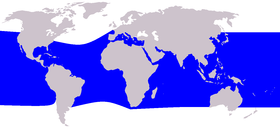Rough-toothed dolphin
| Rough-toothed dolphin | ||||||||||||
|---|---|---|---|---|---|---|---|---|---|---|---|---|

Rough-toothed dolphins ( Steno bredanensis ) |
||||||||||||
| Systematics | ||||||||||||
|
||||||||||||
| Scientific name of the genus | ||||||||||||
| Shorthand | ||||||||||||
| JE Gray , 1846 | ||||||||||||
| Scientific name of the species | ||||||||||||
| Steno bredanensis | ||||||||||||
| ( G. Cuvier in Lesson , 1828) |
The rough-toothed dolphin ( Steno bredanensis ) is the only representative of the genus Steno within the dolphins (Delphinidae). It is common in all tropical waters in the world that are of sufficient depth.
The dolphin was first described by Georges Cuvier in 1823. The name steno comes from the Greek word for 'narrow' and refers to the animals' snout shape, which is characteristically narrow. The epithet is dedicated to van Breda, who evaluated the writings of Cuvier. The common name, on the other hand, refers to the narrow lines that are located vertically on the dolphin's teeth.
features
The rough-toothed dolphin is up to 2.50 meters long and weighs around 150 kilograms. The lips, the throat and the belly of the rough-toothed dolphin are colored pink-white, the flanks light-gray and the back and the fin are darker gray.
The most characteristic feature is the conical head with the very narrow snout. The pectoral fins ( flippers ) are significantly further back on the body than other similar dolphins. At sea there is a risk of confusion with the slender dolphin ( Stenella attenuata ) and the East Pacific dolphin ( Stenella longirostris ) as well as the bottlenose dolphin ( Tursiops truncatus ).
behavior
Like many other dolphins, this species is very social and usually occurs in groups of 50 to 100 animals. The rough-toothed dolphins know two ways of traveling: Either the individual animals swim in a loose group at different speeds or they form a group and precisely coordinate their direction and speed. Instead of constantly producing ultrasound calls for their sonar , most animals prefer to listen to the calls of a conspecific when swimming in a group and orient themselves accordingly. If the animals swim side by side in a disorderly fashion, several individuals always produce the typical ultrasonic calls at the same time. In synchronized swimming, on the other hand, usually only one animal made noises.
So far, no "surfers" have been observed in this species, but he often swims with his head and neck over water (" skimming ").
distribution
The exact distribution and above all the population structure of the rough-toothed dolphin is so far unknown. Most of the research comes from the eastern Pacific , where a population size of around 150,000 animals is assumed. In addition, the animals also live in the warm seas and oceans of the Atlantic including the Mediterranean , the Caribbean and the Indian Ocean . The sightings take place exclusively in the high seas away from the coasts.
threat
This species is not assumed to pose a threat to humans. Some of these dolphins get caught in trawls when fishing for tuna ; very few have been actively hunted.
literature
- J. Maigret: Steno bredanensis. In: J. Niethammer, F. Krapp (Ed.): Handbook of Mammals in Europe. Volume 6: Marine Mammals. Part 1A: whales and dolphins 1. Aula-Verlag, Wiebelsheim 1995, ISBN 3-89104-560-3 .
Referenced sources
- ↑ Large eavesdropping in the water. December 21, 2005, accessed on September 11, 2019 (Dolphins use the calls of their conspecifics to navigate).
Web links
- Steno bredanensis in the endangered Red List species the IUCN 2006. Posted by: Cetacean Specialist Group, 1996. Retrieved on 12 May, 2006.
